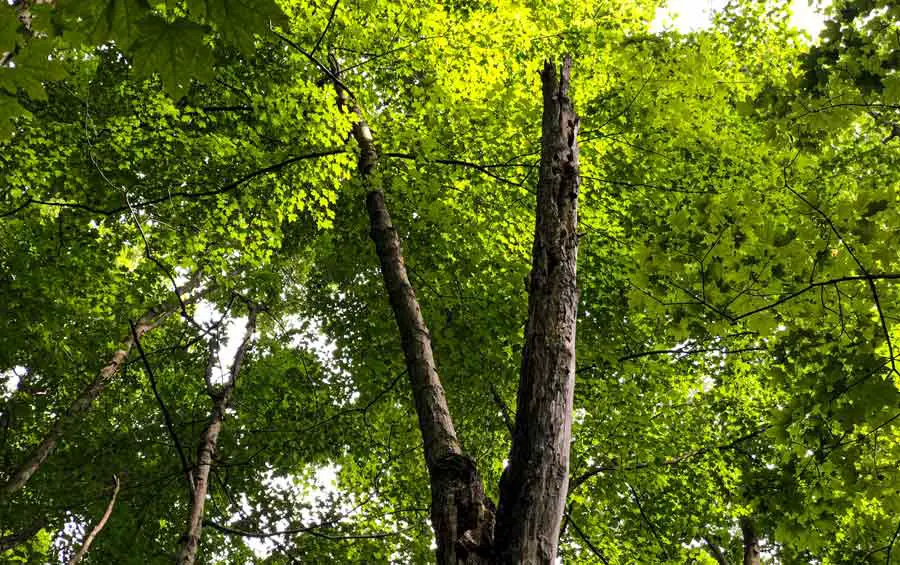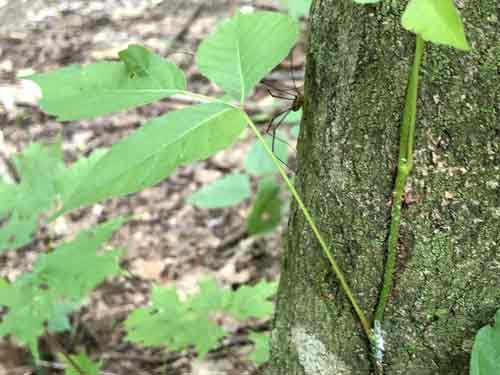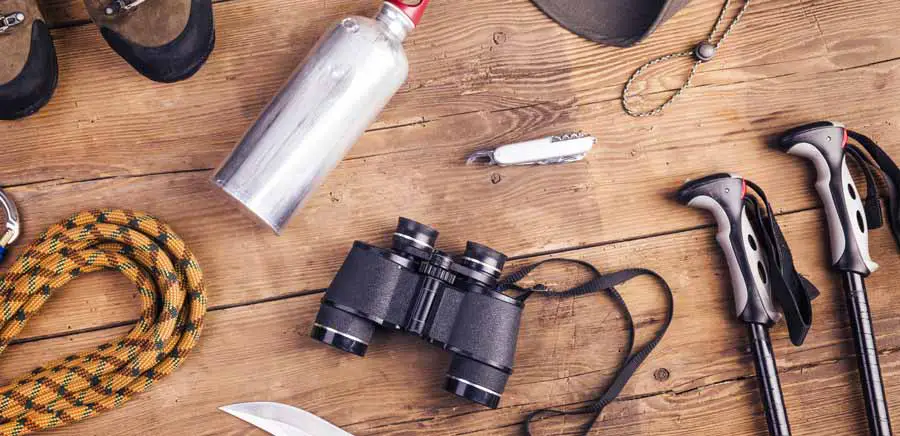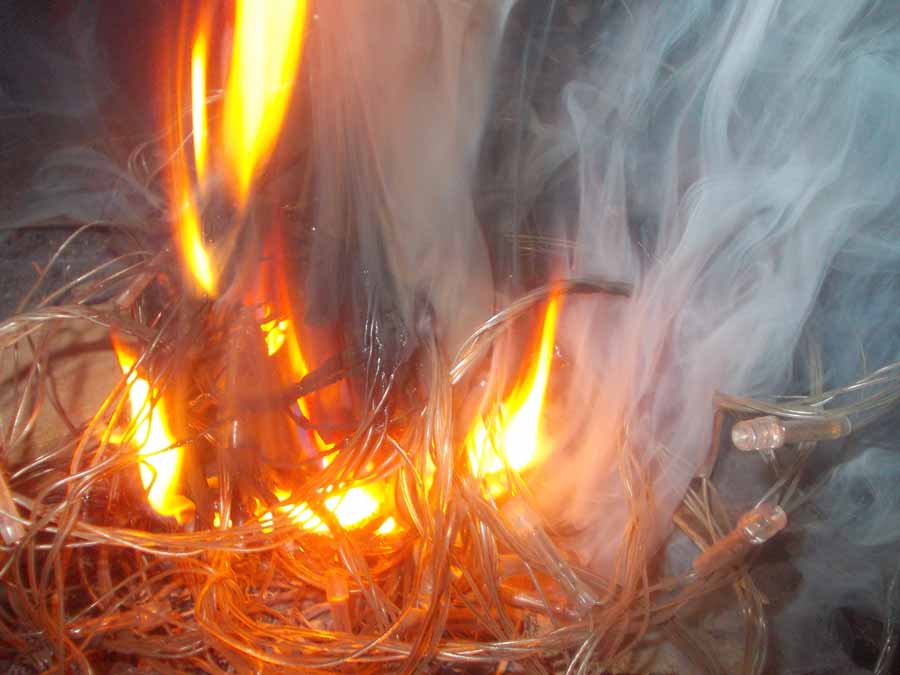It doesn’t matter if you are tent camping or a hammock camper, there are inherent risks and dangers that you will need to be aware of. While there are several overlapping concerns on the list for all campers, there are a few others that hammock campers need to take note of as well.
As much as I love hammock camping, I have always promised to be upfront and honest on this blog. There are some disadvantages to hammock camping, but for me, the pros still outweigh the cons. This article will list some of the drawbacks that come with higher safety concerns – things that I feel every hammock camper should be aware of before they ever spend a night in their hammock.
If you are considering switching from a tent to a hammock, be sure to research and know about the potential dangers. The good news is that many risks on this list are preventable. Let’s get into it.
1. Widowmakers
Widowmakers take the number one spot on this list because they have the potential to significantly injure or cause fatalities – life and death risk here. For those of you who aren’t familiar with the term ‘widowmaker’ it is a dead branch or branches hanging from a tree that can become dislodged and fall to the ground. These branches can be large and difficult to spot in the canopy. The trees you choose need to be completely healthy from top to bottom. Mistaking a dead tree for a healthy tree can be disastrous and possibly deadly. Hence the name, widowmaker.
You should also check any other trees close to the tree you are planning to hang from and make sure they are healthy as well. Dead branches can fall into neighboring healthy trees and get wedged between the branches high up in the canopy. It only takes a little wind and those branches come tumbling to the ground.

Solution
You can significantly reduce your risk by knowing what to look for. Careful inspection of your trees and the canopy will be the best prevention.
- Set up only in the daylight. Always set up when you have plenty of sunlight. Widowmakers can be tricky to see and giving yourself as much light as possible will allow you to identify them more easily.
- Don’t EVER choose your trees in the dark. To help drive home the last point, don’t ever hang your hammock on an unknown tree in the dark. A flashlight isn’t going to provide enough light for proper inspection.
- Listen for the sound of rubbing branches. If you hear the sound of wood rubbing, it is likely that you are near a widowmaker.
- Don’t be fooled by greenery. Make sure the green leaves you are seeing in a tree and on branches are actually part of the tree. Climbing plants and vines can often create the appearance of tree leaves on dead trees. Follow the branches with your eyes to be sure that the leaves you are seeing are actually tree leaves and look for evidence of climbing plants.
- Check neighboring trees. The tree you’ve selected may be healthy, but if there are dead trees close by, they can drop dead branches into your healthy tree. If a dead tree is crowding into the healthy tree, walk away. It’s better to err on the side of caution.
Rule of thumb: if you are ever in doubt about a tree, move on and find another. It’s not worth the risk.
ALSO READ: 12 Tips for Choosing Trees for Hanging Your Hammock
2. Poisonous Plants
The probability that you will come into contact with some sort of poisonous plant while hammock camping is high. I see poisonous plants on every camping trip or hike I go on. Getting an itchy, painful rash while camping is the worst. While usually not life-threatening, it will still make for a miserable trip.
You don’t need to be a botanist to be able to easily identify poisonous plants. You just need to know the characteristics of what they look like and where and how they grow. Plant identification was one of the first things I taught my young boys about being in the woods. It’s an important skill to have and it’s worth it to take the time to learn.

Solution
The solution to this is straightforward and preventable.
- Look up the poisonous plants in the area you plan to camp in. It only takes a few minutes to do a quick search and take notes about the poisonous plants in a given location. Here’s a useful resource from the CDC on where the most common poisonous plants are found in the U.S. Poisonous Plants by Geographical Location
- Know your plant identification. The best way to prevent contact with these plants is to know what they look like and where they grow. Poison Ivy likes to climb up trees.
- Keep your gear away from plant oils. You can easily get the oils from the plants on your gear if you aren’t paying attention. Setting your pack down, wrapping straps around a tree with Poison Ivy climbing it, your hammock rubbing against plants are all common ways the plant oil can soil your gear and transfer to your skin.
- Inspect your campsite. When I have spotted a potential tree candidate, I will first take a good look at the ground area around the tree and inspect the trunk for climbing vines.
Rule of thumb: Knowledge is power. Take the time to research how to accurately identify poisonous plants and don’t be afraid to move your campsite to another area.
3. Wild Animals

Wild animals are a concern for all campers depending on the area you choose to camp in. You should be aware of the wildlife where you are camping and know if there are any dangerous animals that you could run into during your trip.
Solutions
- Bear containers. Bears are attracted to campers’ food. If they get a whiff of something tasty, it can bring them right to your campsite. You don’t want this to happen. It’s wise to have a bear container to keep your food in while you’re camping. If you are camping in an area with bears, hang your bag of food in some type of air-tight container at least 100 feet away from your campsite. Tie it to some cordage and string it up on a high branch that is at least 10 feet above the ground and 4-5 feet away from a tree trunk.
- Look for animal and game paths. If you know how to spot animal paths, you can find their regular routes of travel and know where to stay away from. Animals are creatures of habit and they tend to travel the same trails often. Avoid those trails and you will significantly lower your risk of having a run-in with a wild animal.
- Hang your hammock higher from the ground. If there is a lot of animal activity in the area you are camping in, you can choose to hang your hammock higher up. Instead of hanging only 18 or so inches from the ground, you will want to hang about 4-5ft from the ground. If you’ve already read a few of the articles on my site, you probably already know I’m always concerned about safety. Hanging higher also comes with its own risks – specifically fall hazards. However, if you need to stay away from the woodland creatures, such as raccoons and coyotes, the benefits may outweigh the risks.
Rule of thumb: If you see signs of animals, don’t set up camp there, but you probably already know that.
4. Faulty Equipment
This ‘danger’ is something that can take you by surprise if you’re not mindful of it. Hammock camping equipment, just like any camping equipment, doesn’t last forever. It is for this reason that it is imperative to do equipment and gear checks regularly.
I inspect all of my gear about a week ahead of any trips I have on the calendar. This way, if I find that any of my gear needs replacing, I have plenty of time to order or go buy the replacement.
Equipment failure does happen and it can result in injuries if the failure causes you to fall. Accidents do happen, but doing all you can to prevent them is crucial. The last thing you want to happen in the middle of your camping trip is your gear to fall apart and be left with no options.
Solutions
- Thoroughly inspect ALL your gear. Take the time to inspect all of your gear and equipment before you use it – preferably before you pack it. It doesn’t take much time at all to look over your gear and ensure that it is safe to use.
- Check for cuts and tears in your hammock. Most hammocks are made of ripstop nylon so it won’t just tear wide open when you get in it. If you don’t check for cuts, tears, and holes, you are risking the structural integrity of the hammock.
- Check for UV damage. The sun is harsh and can degrade your hammock material over time.
- Check strap integrity. It is vital for your straps to be in good condition. You should not use straps that are worn, torn, tattered, or frayed.
Rule of thumb: Plan a time well before your trip to check your gear. Make it a habit.
5. Unprepared

Let’s just be honest. Everyone forgets things. It happens. It’s human nature. It is for this reason that I heavily rely on checklists and to-do lists to remember everything I need to hammock camp.
The thing about hammock camping is that the gear is reliant on all the other gear for proper setup. Your system is broken and you cannot do without most components of your hammock system. If you forget straps, you can’t hang your hammock. If you forget your insulation system, you won’t be able to stay warm. If you forget your rain fly, you won’t stay dry – although in this case you may get lucky and it won’t rain. The point I am making here is that most everything in hammock camping is dependent on something else and it’s hard to make things work when you forget things.
Depending on what equipment you forget, you could put yourself at risk. Things like insulation systems are non-negotiable for hammock camping, especially in temperatures below 70 degrees. You will get cold – too cold for your body to handle. Getting wet and being cold is a recipe for hypothermia. You definitely want to avoid that.
Solution
- Make a checklist ahead of time and use it. List out all the gear and equipment you will need. Make sure to spend time making this checklist and really think it through. Obviously, use the checklist as you pack for your trip.
- Do a practice set up. If you are new at hammock camping – or if you’re not – make sure your list is complete by doing a practice set-up in your yard.
- Don’t assume. This is simple, but it’s easy to get caught up in and end up ill-prepared. It’s so easy to think that you’ve packed something when in reality you got distracted and forgot it. The intention doesn’t count.
Rule of thumb: Make a list and check it twice. Do it.
Here’s a link to the list that I use. Feel free to use it for your next trip.
Falling Out
Falling out of your hammock is probably one of the most obvious things that come to mind when you think of the dangers of hammock camping. It’s easier than you might think to fall out of your hammock. It isn’t fun, either. Most hammock campers have done it at least once, myself included.
Most falls happen when you are getting into or out of your hammock. People don’t usually fall out of the hammock while they are sleeping. It’s more when things happen like when nature calls, for instance. Having to get out of your hammock half-asleep and disoriented creates perfect fall risk conditions. Falls can also occur if you aren’t paying attention, messing around, or not aware of your gear.
I have fallen because I mistook my underquilt for my hammock. I sat back in the underquilt and down to the ground I went. Apparently, I’m in good company as others I have spoken to have done the exact same thing. The lesson here is to pay attention to what you are doing.
Solution
- Practice getting into and out of your hammock. It may seem silly to practice this, but trust, it will help you develop the muscle memory of getting into and out of your hammock. When you go to get into your hammock, spread it out and put your butt in first. NEVER put your feet in first when getting into a hammock. You’re just asking for trouble. Butt first, feet last.
- Pay attention to what you are doing. Take your time and watch what you are doing. Get in and out of your hammock slowly and carefully. Double-check that you have the hammock under you and not another piece of gear.
Rule of thumb: Don’t hang your hammock higher than you are willing to fall.
Fire Safety
This is another in the ‘general camping’ category. It’s a serious topic and all campers should be aware of fire safety measures when they are camping or hiking. The risks with fire go beyond the camper and the campsite when things go wrong. For the purpose of this specific article, I’m going to stick to fire safety as it pertains to hammock camping.
Most hammocks are made of nylon which is a plastic-based fabric. Plastic melts so you need to keep your hammock away from your campfire and also far enough away so that the floating embers can’t reach your hammock. If you don’t heed this warning, you will end up with one of two things: a melted hammock or a hammock that looks like a slice of swiss cheese.

Solution
- Keep your distance. The most important thing is to consider the distance from the fire. You will significantly minimize the risk that your hammock or rainfly gets damaged by falling embers if you keep your setup no closer than 9 feet (3 yards) from the fire. This isn’t foolproof or guaranteed, but it does help a lot. You will have to be the judge of your own situation.
Rule of thumb: “Only you can prevent forest fires.” Smokey the Bear (I had to, guys.)
ALSO READ: Can I hammock camp with a fire under my tarp?
Just Be Smart About It
Honestly, when it really comes down to it, the key is just being smart about it and use common sense. This article doesn’t cover all of the dangers that could happen while hammock camping, but it does cover the ones that I have seen and heard about the most.
You need to do your research about the areas you plan to camp at. Make sure that you are aware of the risks specific to that location. Things can happen that you will never be able to predict or prevent, but having some knowledge will get you a lot further than none at all.
Arm yourself with as much knowledge as possible and set yourself up for success. Have a fun and safe time out in The Wanderful Wild.
